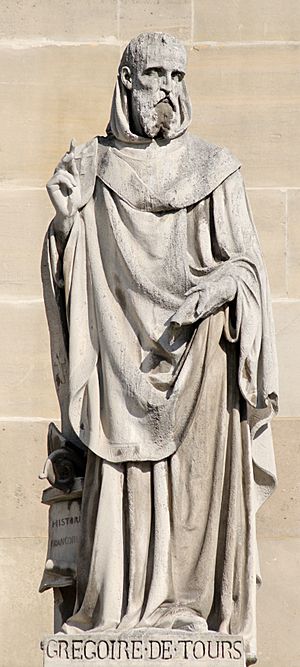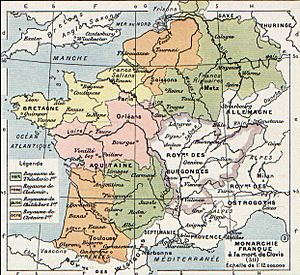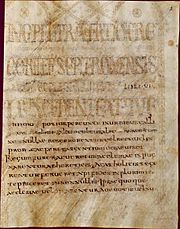Gregory of Tours facts for kids
Quick facts for kids SaintGregory of Tours |
|
|---|---|

|
|
| Bishop of Tours | |
| Born | 30 November c. 538 Auvergne, Austrasia (now France) |
| Died | 17 November 593 or 594 Tours, Kingdom of Orleans (now France) |
| Venerated in | Catholic Church Eastern Orthodox Church |
| Feast | 17 November |
Gregory of Tours was an important historian and a Bishop (a high-ranking church leader) in a region of France called Gaul. He lived from about 538 to 594 AD, during a time known as the Merovingian period. He is often called the "father of French history" because of his writings.
Gregory's most famous work is called Decem Libri Historiarum, which means "Ten Books of Histories." It's also known as Historia Francorum, or "History of the Franks." This book is a very important source for understanding the history of the Franks, a powerful group of people who lived in what is now France. Gregory also wrote about important religious figures, like Martin of Tours. His writings helped make the Tomb of St. Martin a popular place for Christian pilgrimage (religious journeys) in the 6th century.
Contents
Biography
Gregory was born in Clermont, a city in the Auvergne region of central Gaul. His family was very important and well-known in Gallo-Roman society. His father, Florentius, was a Senator (a high-ranking official). Many of Gregory's relatives were bishops and saints, showing how influential his family was in the church.
When Gregory was young, his father died. His mother moved to Burgundy, and Gregory went to live with his uncle, St. Gallus, who was the Bishop of Clermont. St. Gallus and his successor, St. Avitus, taught Gregory. Gregory later became a deacon, a church official.
After a serious illness, Gregory visited the tomb of St. Martin in Tours. When he recovered, he decided to dedicate his life to the church. In 573, at the age of 34, he was chosen to be the Bishop of Tours. He didn't want the job at first, but he accepted it.
Gregory spent most of his time as bishop in Tours. This city was a perfect place for him to learn about everything happening in the Merovingian kingdom. Tours was located on the Loire River, which was like a highway for boats. Many Roman roads also met there, making it a busy center for travel and trade between the Frankish north and the Gallo-Roman south.

Tours was also a very important Christian pilgrimage site because of St. Martin's tomb. People from all over came to visit, including important leaders who sometimes sought safety there during times of trouble. Gregory met many powerful Frankish kings and leaders, including Sigebert I, Chilperic I, Guntram, and Childebert II.
Works
Gregory wrote in a style of Latin called Late Latin. It was a bit different from the older, more formal Classical Latin, but it was still very important for recording history.

History of the Franks
Gregory of Tours' "History of the Franks" is a detailed book filled with many stories and characters. It includes tales of Christian miracles, descriptions of natural events, stories of saints, and discussions about church debates. It also talks about the lives of holy people, nobles, and ordinary villagers. The book often refers to the Bible and explores the relationships between different groups like the Lombards, Visigoths, and Huns. It also includes Gregory's own thoughts and experiences.
Book 1: From the Beginning to 397 AD
This book starts with Gregory explaining that he is a Catholic clergyman who believes in the Nicene Creed and dislikes other beliefs, like Arianism. He then gives a quick summary of the Bible and how Christianity spread into Gaul. He covers the history of Christianity in Gaul and important events involving the Romans and Gauls. It ends with the death of Saint Martin of Tours in 397 AD.
Book 2: 397-511 AD
Book Two describes the start of the Merovingian dynasty. It tells how King Clovis I became a Christian, thanks to his wife Clotilde. The book ends with Clovis's death in 511 AD, after he had conquered many lands in what is now France.
Book 3: 511-548 AD
This book follows the four sons of King Clovis, who divided his kingdom after his death. These kings—Theuderic I, Clothar I, Childebert I, and Chlodomer—often argued and fought for control. However, they sometimes worked together, like when they attacked the Burgundians in 523. Eventually, Clothar became the most powerful king. The book ends with the death of King Theoderic I's son, King Theudebert I, in 548 AD.
Book 4: 548-575 AD
Book Four continues the story after the deaths of King Childebert in 558 and King Clothar in 561. For a few years, Clothar ruled the entire Frankish kingdom. After his death in 561, the kingdom was again divided among his four sons: King Charibert I, King Sigibert I, King Guntram, and King Chilperic I. They also fought for control. After King Charibert I died in 567, the remaining brothers continued to fight. King Sigibert was the strongest militarily. Book Four ends with King Sigibert's killing in 575. Gregory blames Fredegund, the wife of King Chilperic, for this murder.
Book 5: 575-581 AD
This book is where Gregory starts writing about events he knew personally. These later books are longer and more detailed, even though they cover shorter periods. Book 5 also includes Gregory's thoughts on church matters he saw or was involved in. It mentions a possible debate Gregory had with a rival Arian church leader. This book also introduces Childebert II, the son of the recently killed King Sigibert. Childebert and his mother, Brunhilda, were protected by King Guntram, who was King Chilperic's brother.
Book 6: 581-584 AD
In Book Six, the young Childebert breaks his alliance with his uncle King Guntram, who had protected him and his mother. Instead, Childebert forms an alliance with his other uncle, King Chilperic, who had often been an enemy of Childebert's father. Later, King Chilperic is mysteriously murdered in 584.
Book 7: 584 AD
In Book Seven, Fredegund becomes the ruler for her young son, Clothar II. Clothar II would later become king of all Franks. Fredegund and her son are protected by King Guntram. This book also tells about the rebellion of Gundovald, who claimed to be a lost son of King Chlothar I. Many Frankish nobles supported him, but King Guntram quickly stopped the rebellion.
Book 8: 585 AD
Gregory writes that "Many evil things were done at this time." This book describes King Guntram's travels and his arguments with some bishops. King Guntram becomes ill and worries about his life. Gregory suggests the illness is a punishment because the king planned to send many bishops away. Fredegund tries to have King Childebert and Brunhilda killed, but her plan fails. Fredegund is also behind the murder of Bishop Praetextus of Rouen. King Guntram's army attacks Arian Septimania and Spain but fails.
Book 9: 586-587 AD
In Book Nine, an important agreement called the Treaty of Andelot is signed in 587. It is a strong alliance between King Guntram, Brunhilda, and King Childebert II. In this treaty, Childebert is officially adopted as Guntram's heir, meaning he would inherit Guntram's kingdom. Brunhilda also officially allies with Guntram and comes under his protection.
Book 10: 587-591 AD
The last book is set around 589. It tells about a short revolt led by Basina, the daughter of King Chilperic I, from a nunnery. Gregory also lists and describes the 18 Bishops of Tours. The book ends with a summary of Gregory's other writings.
Hagiographies (Stories of Saints)
Gregory also wrote Life of the Fathers, which contains twenty stories about important holy men of his time. These stories include bishops, monks, and hermits. He praised them for qualities like purity, discipline, faith, and justice. For example, he wrote about Nicetius of Trier, a bishop of Lyon, who was known for his great authority and responsibility. Gregory even included himself in some of these stories, like in the life of St. Leobardus. This helped connect the spiritual world of saints to the everyday world.
In 587, Gregory started writing Book of the Glories of the Martyrs. This book mainly focuses on the miracles performed by martyrs (people who died for their faith) in Gaul during Roman persecutions. It also tells the story of Theodore, who traveled to India and reported finding a large monastery where the body of Thomas the Apostle was first buried and where miracles happened.
Fighting Against Wrong Beliefs
Gregory's main goal in writing these books was to inspire people to be more enthusiastic about Christianity. He wanted to show readers the importance and power of their faith. He paid close attention to how Christianity was practiced in local churches throughout Gaul. He told stories that connected miracles, saints, and their relics (holy objects) to many local areas. This helped people feel a stronger connection to their local shrines and understand their faith better.
Gregory also used his writings to fight against beliefs he considered wrong, especially Arianism. He often showed how God protected Catholics while those with "wrong" beliefs faced difficulties. This was very important for Gregory because he was the bishop of Tours, a key religious center. He used the stories of saints, especially St. Martin, to strengthen the authority of his bishopric.
Gregory's Strong Beliefs
In his "History of the Franks," Gregory included a statement of his faith. He wanted to make sure his readers knew he was a true Catholic and that he opposed any beliefs he considered heresies (wrong teachings). He believed in God the Father, Jesus Christ as God's Son, and the Holy Spirit, all being equal and eternal. He also believed that Mary remained a virgin after Jesus' birth. He strongly supported the decisions made by church leaders at the Council of Nicæa.
Legacy
Gregory's "History of the Franks" is a very important source for understanding early Frankish history. It describes the time when the Roman Empire was fading and the early medieval period was beginning in Europe. It is considered the only reliable source that describes how the Franks became a powerful kingdom.
Gregory's Latin writing style was not as polished as writers from earlier times, and he even apologized for it in his introduction. However, his work is still incredibly valuable. The "History of the Franks" is the only source from that period that covers the beginning of the Franks in the Roman Empire, from around 397 AD to 590 AD.
Gregory's stories about saints are also full of interesting details and anecdotes that help us understand what life and beliefs were like in Merovingian Gaul. His main goal was to show readers the importance and strength of Christianity. Along with the poet Venantius Fortunatus, Gregory of Tours is the only major historian from the 6th-century Merovingian world. His many writings show that learning continued and that Gallo-Roman culture lasted through the early Middle Ages.
See also
 In Spanish: Gregorio de Tours para niños
In Spanish: Gregorio de Tours para niños
- Bede
- Brunhilda of Austrasia
- Jordanes
- Widukind of Corvey

